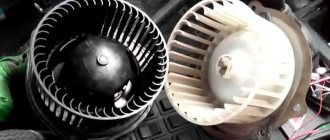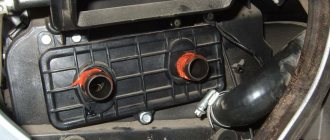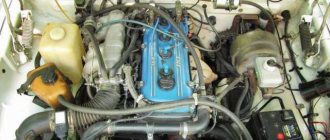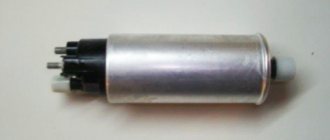The cabin is equipped with supply and exhaust ventilation systems.
With natural ventilation, air enters the vehicle interior through lowered door windows and exits through the cracks in the interior panels of the front doors, the sunroof, as well as ventilation windows on the rear side pillars and rear windows of buses.
With forced ventilation, the windows and sunroof are closed, the outside air, without heating, is forced into the cabin by the heater fan.
Passing through the heater body and bypassing its radiator, the air enters the cabin.
To do this, move the lower handle on the control panel to the extreme left position and turn on the electric fan.
The direction of air flow through the cabin is controlled by rotating nozzles.
Forced ventilation should be used in hot weather at low speeds and in parking lots.
At speeds above 50 km/h, the interior is ventilated with the electric fan turned off, only due to the high-speed air pressure.
The cabin (salon) is heated with hot air.
Passing through a heated heater radiator (included in the engine cooling system parallel to the main radiator), the air is heated and supplied to the passenger compartment.
When outside air is taken in, it passes through a grille located between the windshield and the hood, abruptly changes direction and is separated from rainwater, which is drained onto the road through a plastic groove located in the engine compartment.
Next, the air passes through the air intake duct, the heater itself and (depending on the location of the dampers) is supplied to the windshield, door windows, and also to the driver’s and passengers’ foot area.
The heater consists of a plastic casing in which a radiator, two fans mounted on the electric motor shaft, upper, central and lower dampers and a control panel with three levers and switches are installed.
An additional resistor is installed on the left side of the heater, providing reduced rotation speeds of the electric fan.
The inlet and outlet rubber hoses are suitable for the heater radiator.
When the heater tap is open, fluid is drawn into the radiator from the cylinder head, and discharged into the engine cooling system pump.
To heat the cabin, by moving the right upper and lower levers of the control panel, open the heater tap, and by moving the dampers we direct the incoming air through the heater radiator.
When the car is moving, air will flow into the cabin even when the fan is turned off.
If there is a lack of warm air, as well as in parking lots, we turn on the electric fan.
By turning the switch clockwise, we select one of three operating modes of the electric fan.
To increase heating efficiency and, especially, speed up the warm-up of the cabin in the cold season, cabin air is recirculated through the heater radiator.
When the upper left lever of the heater control panel is moved to the extreme right position, the upper flap blocks the flow of outside air into the heater and opens the air intake window from the passenger compartment.
The constant circulation of “cabin” air through the heater radiator contributes to its intensive heating.
The redistribution of air flows in the cabin is carried out by the lower lever of the heater control panel.
When the handle is in the extreme left position, the air supply to the heater radiator is blocked and only the interior is ventilated.
In the middle position, air is supplied to heat the windshield and door windows.
When on the far right, the air is distributed in the same way as the middle position of the handle, plus it additionally flows to the foot area of the driver and passengers.
The upper right lever of the heater control panel is connected to the heater valve and controls the amount of fluid entering the heater core. When the lever is in the extreme right position, the valve is fully open.
Additional heater
An additional heater is installed in the heating system of vehicles with two rows of seats, buses and emergency vehicles.
When the electric fan is turned on, the interior air circulates through the auxiliary heater radiator.
This ensures high intensity heating of the cabin (interior).
The auxiliary heater fan has a minimum and maximum rotation speed.
The auxiliary heater radiator is connected to the main heater radiator by hoses. They are laid on the floor and protected by a plastic casing.
The second radiator causes a decrease in the rate of fluid circulation in the heating system.
Therefore, an electric pump is installed together with the additional heater.
It increases the fluid flow in the system, which improves the heating of the air passing through the heater radiators.
The electric pump is included in the drain line of the heating system and is installed in the engine compartment on the right side member.
It is recommended to use the electric pump when parked and at low crankshaft speed (travel speed up to 50 km/h).
At high speeds, the engine cooling system pump develops sufficient capacity to circulate fluid through the auxiliary heater.
The additional heater is installed in buses (with a capacity of up to 9 seats), vans with two rows of seats and in the GAZ-32214 car - on the floor, behind the passenger seat of the cabin, and in buses with 12 (13) seats - on the floor, in the front part of the passenger compartment .
To heat the interior of minibuses of medical modifications, an independent flame-type heater is additionally installed, running on gasoline supplied from the vehicle tank.
The heater can operate while stationary or in motion, regardless of engine operation.
Types of pumps
There are two types of additional pump for the stove - dry and wet. Which option the car owner chooses depends on the characteristics of his Gazelle and equipment requirements.
Dry
A dry pump for the Gazelle stove is needed by the driver who is most interested in performance. The main distinguishing feature of such pumps is hermetic insulation from the motor. That is, the rotor has no contact with the coolant, hence the name.
The need for dry-type pumps in Gazelles, which are actively used by the driver in low temperature conditions, has been proven. The efficiency of such a stove heater is almost one hundred percent - 80%. So it is recommended to use it for large volumes of work.
One of the disadvantages of a dry additional pump is a large amount of noise. But for the sake of efficient operation, many drivers sacrifice a little comfort.
Water
Drivers who prefer a water heater are economical lovers of comfort. The characteristics of a wet stove heater are much inferior to the previous dry type (efficiency on average does not exceed 30-50%). But such heater pumps can be installed in a Gazelle stove without fear of noise and frequent breakdowns.
The wet pump makes up for its low efficiency with its long service life. Having installed such an additional pump for the stove heater, the driver may not return to it for a very long time - the device will quietly serve for several years without maintenance, essentially being self-service. When the need to replace a wet heater pump does arise, there will be no problems with this, since the device can be easily removed and replaced.
The main difference between a wet pump and a dry pump is cooling using water. Pumps of this type are installed directly into the coolant medium, facilitating its circulation. The stator is used to supply electricity.
Foreign pumps
Despite the fact that the Gazelle is a domestic car, additional pumps for it can be imported. The Gazelle stove pump from Bosch is very popular; there is no doubt about the quality of its products. A device from a German manufacturer will serve you longer and with better quality, and there will be much fewer questions about how to install and configure it.
Many drivers fear that an imported pump for a Gazelle stove will cost them too much, but this is not the case. The German additional pump for Gazelles will only slightly exceed the price of the one assembled by the original manufacturer.
For a small increase in cost, the driver will receive:
- Long service life without replacement or minor repairs;
- Possibility of independent installation and maintenance;
- Leaks are excluded. The mechanism for the Gazelle stove from Bosch is sealless. This means it is protected from excess pressure inside.
When choosing an additional pump for a Gazelle stove, most will choose the safe, clean and reliable German version. There is no reason to try to save money and risk the stove by buying a new, domestic pump every year.
Design of the cooling system for UMZ-4213 and UMZ-4216 engines on UAZ and GAZelle vehicles.
To increase energy performance, improve fuel economy, reduce toxicity and noise, models with an integrated microprocessor fuel injection and ignition control system were developed on the basis of the UMZ-421 carburetor engine: UMZ-4213 engine for UAZ cars and UMZ-4216 for GAZelle cars. The design of the cooling system on the UMZ-4213 and UMZ-4216 is somewhat different, since it has differences in the connection diagram of the expansion tanks and heating radiators.
General design of the cooling system of UMZ-4213 and UMZ-4216 engines on UAZ and GAZelle vehicles.
The cooling system is liquid, closed, with forced-type liquid circulation and an expansion tank, with liquid supply to the cylinder block. It includes a water pump, a thermostat, water jackets in the cylinder block and cylinder head, a heater, an expansion tank, a fan, connecting pipe sections, and also body heating batteries.
For proper operation of the UMZ-4213 and UMZ-4216 engines, the coolant temperature must be maintained within the range of plus 80-90 degrees. Short-term operation of the engine is allowed at a coolant temperature of 105 degrees. This mode may appear during the heat of the year when the car is driving with a full load on long climbs or in city driving conditions with frequent accelerations and stops.
Design of the UMZ-4213 engine cooling system on a UAZ vehicle.
Design of the UMZ-4216 engine cooling system on a GAZelle car.
Operation of the cooling system of UMZ-4213 and UMZ-4216 engines on UAZ and GAZelle vehicles.
Maintaining normal coolant temperature is done using a two-valve thermostat TS-107-01 with solid filling. When the engine warms up, when the coolant temperature is below 80 degrees, a small circle of coolant circulation operates. The upper valve of the thermostat is closed, the lower valve is open.
The coolant is pumped into the cooling jacket of the cylinder block by a water pump, from where, through holes in the upper plate of the block and the lower plane of the cylinder head, the liquid penetrates into the cooling jacket of the head, further into the thermostat housing and through the lower valve of the thermostat and the connecting pipe section - to the pump inlet for water. The heating device is disconnected from the main coolant flow.
For better operation of the interior heating system when circulating liquid in a small circle, and such a situation can be maintained for a very long time at low sub-zero ambient temperatures, there is a throttle hole with a diameter of 9 mm in the liquid outlet channel through the lower valve of the thermostat. Such throttling leads to an increase in the pressure drop at the inlet and outlet of the heating radiator and a more saturated circulation of liquid through this heating device.
Moreover, throttling the valve at the liquid outlet through the lower valve of the thermostat reduces the likelihood of emergency overheating of the motor in the absence of a thermostat, since the shunting effect of the small circle of liquid circulation is significantly weakened, due to which most of the liquid will flow through the cooling radiator.
Additionally, to maintain the normal operating temperature of the coolant during the cold season, UAZ vehicles may have blinds in front of the heater, thanks to which you can adjust the amount of air passing through the heater.
As soon as the temperature of the liquid increases to 80 degrees or more, the upper valve of the thermostat opens and the lower valve closes. The coolant circulates in a large circle through the heater.
To function well, the cooling system must be completely filled with liquid. When the engine warms up, the volume of liquid increases, the excess is pushed out due to increased pressure from the closed circulation volume into the expansion tank. When the temperature of the liquid decreases, for example, after stopping the engine, the liquid from the expansion tank, under the influence of the resulting vacuum, flows back into the closed volume.
On UAZ vehicles with a UMZ-4213 engine, the expansion tank is specifically connected to the atmosphere. The control of fluid exchange between the tank and the closed volume of the cooling system is changed by 2 valves, inlet and outlet, located in the plug of the heater.
Diagnostics
If the speed control unit fails, then you need to understand which of the elements of the entire circuit has failed. The control of the Gazelle stove is electronic, and all drives are electric.
- To begin with, with the engine turned off, we try to turn the temperature regulator. When you turn it, you should hear clicks from the gear motor. If there are no clicks, then you need to check the power in the block that comes to the tap opening motor. This can be done using a test lamp or a multimeter.
- If the fan speed controller does not work, you need to check its operation in all positions. If it does not work in all positions except the last one, then the reason is a faulty rheostat. If operation is not heard in any of the positions, then you need to check the power supply to the fan block. If power comes in, then it is broken.
- If the stove adjustment works correctly, but the display does not light up, then the display itself or the backlight is faulty.
Gazelle stove diagram
Which pump should you choose in the end?
Not all drivers agree that to ensure high-quality operation of the heating system for the Gazelle, a German additional pump is necessary. The main argument of defenders of the domestic product is that the new pump for the Gazelle stove from the original manufacturer is of higher quality.
Indeed, in comparison with the old pump, the new pump upgrade for the stove looks good, but is still inferior in quality to the German product.
The only thing is that the domestic stove device, which sometimes leaks and generally requires more careful maintenance, has better performance. The original pump for the Gazelle stove can warm up the interior faster and easier.
But the price of such short-term convenience will be the effort that the driver will then spend on the stove, changing pumps one after another.
If you are a driver, it is not critical to focus most of your time on the stove in the winter. Then you can take a simple Gazelle additional heater pump.
If the option where you only need to check the part once a season is more suitable for you, take pumps from Bosch.
How the stove works in Gazelle Business
For correct diagnosis and repair, it is important to know the structure and operating principle of the heater, so that at the first sign of a breakdown, you can identify the problem or make repairs, preventing failure of the entire unit as a whole. Most breakdowns can be predicted by subtle signs and their progression can be prevented. To do this, you need to know and understand what any of the components is responsible for and what the meaning of its work is.
Car cooling system
In Gazelle Business, the stove is considered an important part of the engine cooling system. During engine operation, a lot of heat is generated that needs to be removed. Heat is released due to fuel combustion and from rubbing surfaces. If the heat is not removed, the motor will quickly heat up and break down. The cooling system has 2 circuits (small and large circle), they are divided by a thermostat. When the liquid is cool, it moves in a small circle, and when it warms up, it moves in a large circle. This makes it possible to quickly reach operating temperature and not get too hot. In the warm season, heat is released into the atmosphere, and when cool weather sets in, part of the heat is spent on heating the cabin.
Once we understand how the cooling system does not stop working, we can move on to heating the cabin. The heater circuit on a Gazelle car is similar to the heaters of other cars that have a liquid-cooled engine. Liquid can circulate through the heat exchanger of the heater no matter whether the thermostat is open or not. For better heat supply, the fluid for the stove comes from the hottest part of the engine (from the cylinder head). Thanks to this, on an engine that has not yet reached operating temperature, pleasant air still comes out of the deflectors. The heater has a valve in its design that either allows liquid to flow into the heating device or discharges it back. And the temperature of the environment leaving the deflectors depends on how much it is open. The valve position is adjusted from the heater control panel. The faucet is equipped with an electric drive that changes the position of the valve. It is also possible to change the blowing intensity and direction from the control panel. The intensity is controlled by a motor with an impeller, the rotation speed of which changes the intensity of the airflow.
Changing the position of the dampers changes the direction of the airflow (to the face, to the legs, to the chest, to the glass). The heated coolant from the engine penetrates through the line into the heater of the stove, causing it to heat up. At this time, air blown by a fan passes through it. Then it passes through air channels, the dampers of which are open. Then the hot air enters the car interior and warms it up. For repair work or diagnostics of breakdowns of this equipment, there is an electrical diagram on which all components of electrical devices are indicated. And in case of breakdowns or incorrect operation of devices, you need to read it in detail in order to understand where it is powered from and how the failed device changes.
When you know the working principle and device, it is much easier to navigate in case of breakdowns. After all, to successfully carry out a repair, it is necessary to understand the cause of the breakdown, otherwise the repair will not be completed successfully. For correct diagnosis, it is also necessary to understand the method of action of the entire mechanism in general. Nowadays, a driver does not have to know how to repair a car; there are service stations that deal with repairs of varying complexity. But it happens that a problem catches you on the road, and there is no opportunity to use the services of professionals. This is when knowledge of the automotive device and its mechanisms comes in handy. When you know how the Gazelle stove works, then if a breakdown occurs on another car, it will be easier to navigate when carrying out repairs or diagnostics, since in all cars they are almost equal, except for small invisible moments. And you can easily determine the breakdown.
What to assemble with your own hands
Many car enthusiasts like to build things with their own hands in the garage. How to assemble an additional stove for a Gazelle in this case from improvised means? First we need to find a housing that will house all the components and elements of the heater. Even a computer power supply case is suitable for these purposes. It needs to be completely disassembled, even removing the connectors and switch, since the case will be subject to severe overheating.
The second most important component will be the heating element, which will be located inside this housing. For this purpose, we will purchase a piece of nichrome wire or look for it in the garage. As a hint, this material serves as the basis for the manufacture of various springs and clamps. We must wind such a wire around any cone-shaped object. All that remains is to correctly calculate the load that will appear in addition to the standard electrical network.
As already mentioned, the radiator or stove is most often fixed under the right front passenger seat. To put the finished equipment into operation, you should display a button on the front panel - it will provide connection to the equipment. Let us immediately note that the driver needs to be prepared for the fact that it operates quite noisily. But it will cost less than buying a branded heater at a car dealership.











